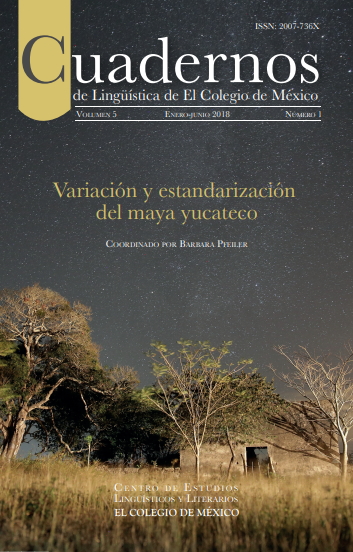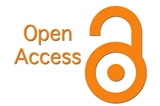<em>The Yucatecan and Cholan tense/aspect/mood systems: Similarities and differences.</em>
DOI:
https://doi.org/10.24201/clecm.v5i1.98Keywords:
Mayan languages, tense/aspect/mood, verb, grammatical systems, comparative linguistics.Abstract
This paper discusses the theoretical problem of correlation between linguistic phenomena inherited from a proto-language and borrowed from neighboring and genetically related languages in the context of the Mayan Lowland area. The grammatical tense/aspect/mood systems in four languages of the Yucatecan branch (Yucatec, Lacandon, Itza’ and Mopan) are very similar in respect to both particular categories and formal structure; this can be explained due to the short period passed from the break-up of Proto-Yucatecan into modern languages. Unlike the Yucatecan branch, the verbal systems of three Cholan languages (Chol, Chontal and Ch’orti’) are very different and apparently emerged independently. The structural similarity between the Yucatecan tense/aspect/mood systems and that of Chol is analyzed as a result of linguistic contact in Mayan Lowlands.Downloads
References
Andrade, Manuel J. & Máas Collí, Hilaria. 1999. Cuentos mayas yucatecos, vol. I. Mérida: Universidad Autónoma de Yucatán.
Aulie, Wilbur & de Aulie, Evelyn. 2009 [1978]. Diccionario ch’ol de Tumbalá, Chiapas, con variaciones dialectales de Tila y Sabanilla. México: Instituto Lingüístico de Verano.
Ayres, Glenn. 1991. La gramática Ixil. Guatemala: Centro de Investigaciones Regionales de Mesoamérica.
Becquey, Cédric. 2012. Quelles frontières pour les populations cholanes? Ateliers d’Anthropologie 37. https://ateliers.revues.org/9181 (Consultado el 22 de marzo de 2017.) DOI: 10.4000/ateliers.9181
Becquey, Cédric. 2014. Diasystème, diachronie: Etudes comparées dans les langues cholanes. Ámsterdam: Vrije Universiteit. (Tesis doctoral.)
Bohnemeyer, Jürgen. 2001. Argument and event structure in Yukatek verb classes. En Ji-Yung, Kim & Werle, Adam (eds.), Proceedings of SULA: The Semantics of Under-Represented Languages in the Americas, 8–19. Amherst: Graduate Linguistic Student Association.
Bohnemeyer, Jürgen. 2002. The grammar of time reference in Yukatek Maya. Múnich: Lincom Europa.
Briceño Chel, Fidencio 2006. Los verbos del maya yucateco actual: Investigación, clasificación y sistemas conjugacionales. México: Instituto Nacional de Lenguas Indígenas.
Coon, Jessica. 2010a. Complementation in Chol (Mayan): A theory of split ergativity. Cambridge: Massachusetts Institute of Technology. (Tesis doctoral.)
Coon, Jessica. 2010b. Rethinking split ergativity in Chol. International Journal of American Linguistics 76 (2): 207–253. DOI: 10.1086/652266
Dugan, James Timothy. 2013. The grammar of Ch’orti’ Maya folktales. Nueva Orleans: Tulane University. (Tesis doctoral.)
Feldman, Lawrence H. 1975. Riverine Maya: The Torquegua and other Chols of the Lower Motagua Valley. Columbia: University of Missouri. (Tesis doctoral.)
García Hernández, Nicolás. 2005. Tradición oral de la cultura Ch’orti’. Guatemala: Academia de Lenguas Mayas de Guatemala.
Hofling, Charles Andrew. 1991. Itzá Maya texts with a grammatical overview. Salt Lake City: University of Utah Press.
Hofling, Charles Andrew. 2000. Itzaj Maya grammar. Salt Lake City: University of Utah Press.
Hofling, Charles Andrew. 2006. A sketch of the history of the verbal complex in Yukatekan Mayan languages. International Journal of American Linguistics 72(3): 367–396. DOI: 10.1086/509490
Josserand, J. Kathryn. 1975. Archaeological and linguistic correlations for Mayan prehistory. En Actas del XLI Congreso Internacional de Americanistas, vol. I, 501–510. México: Instituto Nacional de Antropología e Historia.
K’aaylay. 2006. K’aaylay: El canto de la memoria. Revista de cultura maya. 1 (8) https://kaaylay.files.wordpress.com/2010/01/kaaylay-08.pdf (Consultado el 25 de marzo de 2017.)
Kaufman, Terrence. 1976. Archaeological and linguistic correlations in Mayaland and associated areas of Meso-America. World Archaeology 8 (1): 101–118. DOI: 10.1080/00438243.1976.9979655
Kaufman, Terrence. 1990. Algunos rasgos estructurales de los idiomas mayances con referencia especial al k’iche’. En England, Nora C. & Elliott, Stephen R. (eds.), Lecturas sobre la lingüística maya, 59–114. Guatemala: Centro de Investigaciones Regionales de Mesoamérica.
Kaufman, Terrence & Norman, William. 1984. An outline of proto- Cholan phonology, morphology, and vocabulary. En Justeson, John & Campbell, Lyle (eds.), Phoneticism in Mayan hieroglyphic writing, 77–166. Albany: State University of New York.
Keller, Kathryn & Luciano, Plácido. 1997. Diccionario chontal de Tabasco (mayense). Tucson, AZ: Summer Institute of Linguistics.
Keller, Kathryn & Luciano, Plácido. 2001. Textos chontales. Tlalocan XIII: 59–118. DOI: 10.19130/iifl.tlalocan.2001.156
Knowles, Susan M. 1984. A descriptive grammar of Chontal Maya (San Carlos dialect). Nueva Orleans: Tulane University. (Tesis doctoral.)
Kroeber, Alfred L. 1939. Cultural and natural areas of native North America. Berkeley: University of California Press.
Kuteva, Tania. 1998. On identifying an evasive gram: Action narrowly averted. Studies in Language 22 (1): 113–160. DOI: 10.1075/ sl.22.1.05kut
Kuteva, Tania. 2001. Auxiliation: An enquiry into the nature of grammaticalization. Oxford: Oxford University Press.
Lacadena, Alfonso & Wichmann, Søren. 2002. The distribution of Lowland Maya languages in the Classic period. En Tiesler Blois, Vera & Cobos, Rafael & Greene Robertson, Merle (eds.), La organización social entre los mayas: Memoria de la Tercera Mesa Redonda de Palenque, vol. 2, 275–319. México: Instituto Nacional de Antropología e Historia.
Lacadena, Alfonso & Wichmann, Søren. 2005. The dynamics of language in the Western Lowland Maya region. En Waters-Rist, Andrea & Cluney, Christine & McNamee, Calla & Steinbrenner, Larry (eds.), Art for archaeology’s sake. Material culture and style across the disciplines: Proceedings of the 33rd Annual Chacmool Conference, 32–48. Calgary: The Archaeological Association of the University of Calgary.
Law, Danny. 2014. Language contact, inherited similarity and social difference: The story of linguistic interaction in the Maya lowlands. Ámsterdam: John Benjamins. DOI: 10.1075/cilt.328
Law, Danny, Robertson, John S. & Houston, Stephen. 2006. Split ergativity in the history of the Ch’olan branch of the Mayan language family. nternational Journal of American Linguistics 72 (4): 415–450. DOI: 10.1086/513056
Lehmann, Christian. 1993. The genesis of auxiliaries in Yucatec Maya. En Crochetiere, André & Boulanger, Jean-Claude & Ouellon, Conrad (eds.), Proceedings of the 15th International Congress of Linguistics, vol. 2, 313–316. Quebec: Les Presses de l’Université Laval.
Lehmann, Christian. 2017a. [en prensa] Grammaticalization in Yucatec Maya. En Malchukov, Andrej & Bisang, Walter (eds.), Areal patterns of grammaticalization and cross-linguistic variation in grammaticalization scenarios. Berlín: de Gruyter Mouton.
Lehmann, Christian. 2017b. Grammaticalization of tense/aspect/mood marking in Yucatec Maya. En Bisang, Walter & Malchukov, Andrej (eds.), Unity and diversity in grammaticalization scenarios, 173–237.
Berlín: Language Science Press. DOI: 10.5281/zenodo.823244
Osorio May, José del Carmen. 2005. Análisis de la morfología verbal del yokot’an, “chontal” del poblado de Tecoluta, Nacajuca, Tabasco. México: CIESAS Centro de Investigaciones y Estudios Superiores en Antropología Social. (Tesis de maestría.)
Pérez González, Benjamín. 2006. Los duendes del viento. Literatura chontal de Tabasco. Villahermosa: Gobierno del Estado de Tabasco.
Pérez Martínez, Vitalino. 1996. Leyenda Maya Ch’orti’. Guatemala: Proyecto Lingüístico Francisco Marroquín.
Relatos chontales. 2002. Relatos chontales / Yoko tz’aji. México: Secretaría de Educación Pública.
Robertson, John S. 1992. The history of tense/aspect/mood/voice in the Mayan verbal complex. Austin: University of Texas Press.
Robertson, John S. 1998. A Ch’olti’an explanation for Ch’orti’an grammar: A postlude to the language of the Classic Maya. Mayab 11: 5–11.
Robertson, John S. & Law, Danny & Haertel, Robbie A. 2010. Colonial Ch’olti’: The seventeenth-century Morán manuscript. Norman: University of Oklahoma Press.
Scholes, France V. & Roys, Ralph L. 1996. Los chontales de Acalan-Tixchel. México: Universidad Nacional Autónoma de México.
Schumann Gálvez, Otto. 1997. Introducción al maya mopán. México: Universidad Nacional Autónoma de México.
Schumann Gálvez, Otto. 2007. Introducción a la morfología verbal del chortí. Graz: Academic Publishers.
Schumann Gálvez, Otto. 2012. Introducción al chontal de Tabasco. México: Universidad Nacional Autónoma de México.
Ulrich, Matthew & Ulrich, Rosemary. 1986. Mopan Mayan verbs. Guatemala: Instituto Lingüístico de Verano.
Vázquez Álvarez, Juan Jesús. 2002. Morfología del verbo de la lengua chol de Tila, Chiapas. México: CIESAS Centro de Investigaciones y Estudios Superiores en Antropología Social. (Tesis de maestría.)
Vázquez Álvarez, Juan Jesús. 2011. A grammar of Chol, a Mayan language. Austin: University of Texas. (Tesis doctoral.)
Vinogradov, Igor. 2014. La categoría de incompletivo en las lenguas mayas: Un estudio comparativo de variación semántica. Studii de Gramatică Contrastivă 21: 65–82.
Vinogradov, Igor. 2016. Tense/aspect/mood systems of Cholan-Tseltalan Mayan languages. Múnich: Lincom Europa. Warkentin, Viola & Scott, Ruby. 1980. Gramática ch’ol. México: Instituto Lingüístico de Verano.
Watatani, Jun. 1995. Tense/aspect system of Wastek (Mayan). Eugene: University of Oregon. (Tesis de maestría).
Wichmann, Søren. 2006. Mayan historical linguistics and epigraphy: a new synthesis. Annual Review of Anthropology 35: 279–294. DOI: 10.1146/annurev.anthro.35.081705.123257
Zavala Maldonado, Roberto. 1992. El kanjobal de San Miguel Acatán. México: Universidad Nacional Autónoma de México.
Downloads
Published
How to Cite
-
Abstract1407
-
PDF (Español)785
-
XML (Español)6630
Issue
Section
License
Authors retain copyright of their work and are free to disseminate it, make copies for any use, and/or deposit in any repository or archive of their choice, but they grant Cuadernos de Lingüística de El Colegio de México the right to publish the work for the first time. Authors agree to acknowledge Cuadernos de Lingüística de El Colegio de México as the site of original publication of their article / note / review through proper citation.
Articles appearing in Cuadernos de Lingüística de El Colegio de México are made available to readers under a Attribution-NonCommercial-NoDerivatives 4.0 International.









